Rosie Herrera Dance Theatre, Baryshnikov Arts Center, April 18 and 19, 2013
Anyone who has ever felt fragile or off balance might be heartened by Rosie Herrera’s Dining Alone. Here’s one of many memorable passages. A woman (Ivonne Batanero) holds a stack of white dinner plates; a man (Liony Garcia), crouching beside her, takes the plates, one by one, from the pile and places them on the floor to create a diagonal trail for her to walk on. She never looks down; he gauges where her foot is going to need the next plate. A pianist plays (Beethoven’s “Moonlight” Sonata, I think). Batanero’s voyage can make your heart beat faster, especially when, unburdened, she starts to walk backward on the plates toward the corner where she began. When she reaches it, Garcia, who has been collecting the dishes, puts the whole stack back into her arms. Her legs buckle, and, just as you fear a catastrophe, the rest of the cast rushes onstage in time to catch her and save the plates before she hits the floor.
If you’ve ever felt alone, that’s Herrera’s theme. She also touches on aging and memory. Plus sensuality and greed. A young Cuban American based in Miami, she grew up in her father’s restaurant watching people eat.
Herrera has been hailed as an up-and-comer of consequence. Graduating from Miami’s New World School of the Arts, she has danced in cabaret, knows hip-hop, and sings opera. Dining Alone stirs up memories of Pina Bausch’s works, but Herrera’s approach to dance theater, in addition to being more modest in scale, is lustier, and she links a series of scenes together by common elements (such as plates and eating). When a man dressed as a waiter (counter-tenor Raymond Storms) sings an unearthly aria, he’s carefully polishing cutlery.
The elaborate opening set-up prepares you for evanescence. As spectators enter the Howard Gilman Space at BAC, they’re greeted by the sight of a silent dinner party in progress, with ten invitees seated on either side of a long table that stretches away from the audience. Pianist Fernando Landeros, sitting at the back of the performing area, plays some American Songbook classics, such as Gershwin’s “Sweet Embraceable You” and lesser works like “Part of Your World” from Disney’s The Little Mermaid. The party-goers are frozen in mid gesture—some conversing excitedly, some staring around, some eating. Although they are life-sized photos stiffened by some kind of backing, some appear almost eerily three-dimensional. Guest artist Octavio Campos, the very-much-alive host seated at the head of the table, is devouring his dinner and chatting animatedly at times, although we can’t hear him. Silver-haired, handsome, wearing black pants, white dinner jacket, and a white shirt open at the neck, he presides over a vanished past.
Gradually he becomes minimally more audible, identifying what we’re hearing now as the slow movement from Rachmaninoff’s second piano concerto offering to sing a bit of it (or perhaps the cheesy pop song, “All By Myself,” that’s based on it). He lifts his wine glass: “Bon Appetit!” Suddenly he looks confused, and, in a startling coup de théâtre, the three large objects behind him turn out to be fans, and, in an instant, their fierce wind blows the remembered guests into flat shapes on the floor.
Another surprising, dreamlike event occurs seconds later—after hurrying figures have cleared the darkened stage and David Ferri has restored his fine lighting. Campos, who has been running around the space in increasingly smaller and slower circles, holding out the skirts of a white evening gown that’s attached to his chest, runs toward a cluster of people. Suddenly a woman (Leah Verier-Dunn) is wearing the dress, and he has disappeared. How did that happen?
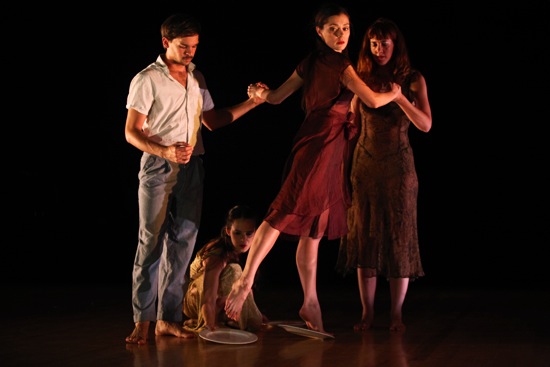
Liony Garica and Katie Stirman assist Melissa Toogood, while Ivonne Batanero manages the plates. Photo: Julieta Cervantes
The crockery performs in a number of ways—both passively and actively. When the dancers sit on the floor and, in perfect unison, put their individual plates on edge and spin them, the objects collaborate both aurally and visually. As they lose their equilibrium, they topple unevenly and continue to try to spin even as they’re flattening out against the floor, their speed and clatter increasing until they stop dead.
One of the loveliest sequences is one in which Melissa Toogood (one of the last and finest dancers in Merce Cunninham’s company) performs a precarious supported adagio on a plate—actually on two plates, but much of the time, she is standing on one leg and flourishing the other, turning and tipping, while Garcia and Katie Stirman help her to do whatever she wants, and Batanero places the second plate should she need to change feet. Once, when Toogood skids a plate some distance away, Garcia and Stirman carry her through the air in a big leap until she can touch down on the new surface. The image is a resonant one. You think of the tale of Sir Walter Raleigh laying his cloak over a puddle so Queen Elizabeth’s feet would not get wet as she walked on. Toogood is wonderfully serene as her intricate dance gradually travels across the space.
Two of the more nightmarish fantasies also involve plates. Garcia sits at a small table, a solitary diner awaiting his meal. Toogood comes and sits down opposite him. But she’s no dinner date—at least not in the usual sense. She bends forward until her forehead touches the plate before her and strokes her long hair out until it reaches her companion’s plate. Carefully twirling her dark locks around a fork as if it were pasta, Garcia dines on them, “eating” steadily as other activities commence. When the waiter comes to take Toogood’s plate away, she walks with him, her head still connected to it.
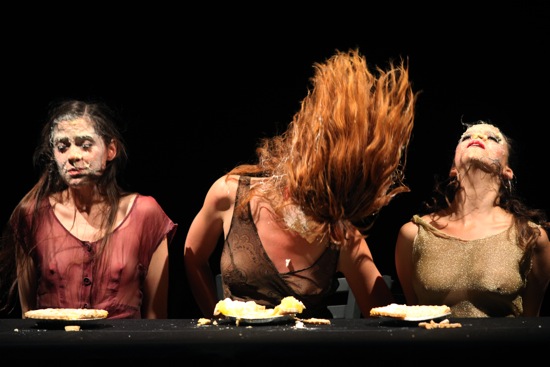
L to R: Melissa Togood, Katie Stirman, and Ivonne Batanero deal with Snow White. Photo: Julieta Cervantes
Herrera is also aware of food as consolation or as voluptuous delight. Toogood, Stirman, and Batanero sit side by side at a long table facing the audience. In front of each is a large, snowy pile of what could be whipped cream. While the recorded voice of Disney’s Snow White sings “Some Day My Prince Will Come” in a high, girlish voice, the three women plop their faces into the white stuff and come up, shaking their heads and shoulders deliriously, pause, and drop down for more. By the time they start lip-synching a conversation among Snow White and two of the dwarves about this handsome guy, their faces and hair are slathered in white. Batanero stays on to “speak” with the voice of Marilyn Monroe in The Seven Year Itch (Herrera’s source for this and other elements—such as the Rachmaninov), while Campos holds her tight. As she wriggles in sexy excitement, he licks and sucks the “cream” off her face and hair. “Don’t stop!” breathes Marilyn.
Dining Alone has many such potent (and funny) images and some excellently apt music, whether recorded or played by Landeros. I can’t identify the gorgeous song (Balkan? Latin?) sung by women’s voices, as Verier-Dunn swoons around the small table top tilted for her by Garcia. There are a few irritating or unfulfilled moments, but the pleasures of experiencing Herrera’s earthy, poetic, beyond-dada imagination outweigh them.
The finale belongs to the plates. Garcia waits at his table, while unseen offstage hands roll one after another of them into the space. Some of them streak straight across and into the wings. Others embark on surprising curves. There are some near misses. Plates clatter into silence. The solitary eater puts his feet on the table’s pedestal out of harm’s way. This is your life, sir. Care for dessert?

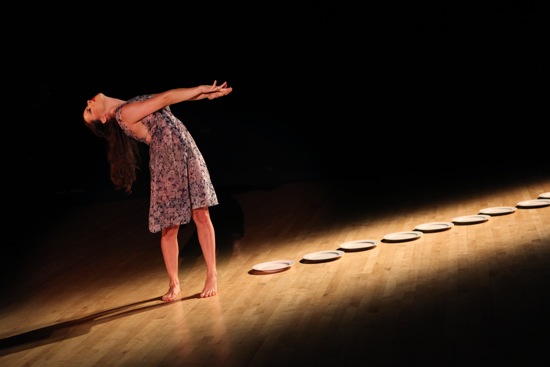
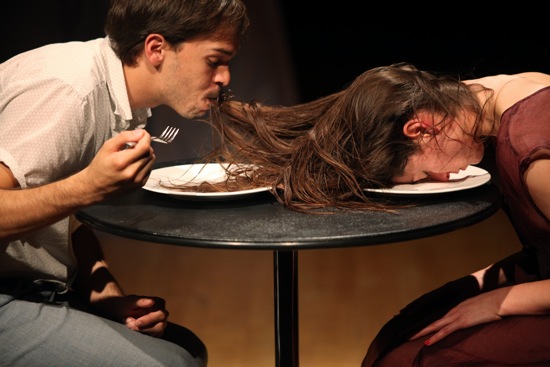
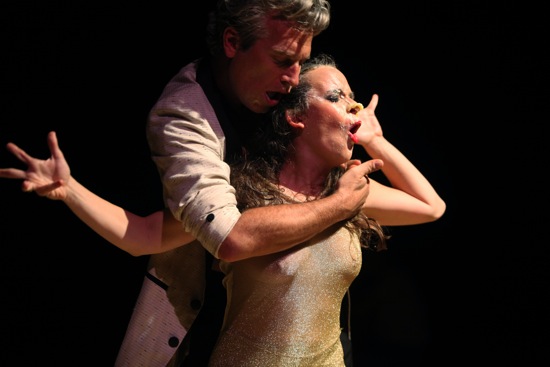
I saw the 9:30 show Thurs, and really enjoyed it. I haven’t seen nor have I been a fan of Pina Bausch (maybe there are 5 of us), so I can’t make the reference, though I thought more of Meredith Monk, but a very young and Latin based Meredith. Or maybe as Octavio Campos says to a stranger in the audience something like , “You just don’t know anything about dance theatre.”
I wouldn’t compare her to Meredith at all or the little Pina I’ve seen, but I was happy to see how dance can be used so naturally in a long work. Am curious what you found irritating or unfulfilled.
this sounds like an interesting piece